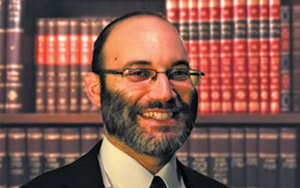
Why would a leading Modern Orthodox rabbi join the Conservative movement at what seemed to be the height of his career? R. Harry Epstein (1903-2003) had impeccable Orthodox credentials. His father, Rav Ephraim Epstein, was the leading Orthodox rabbi in Chicago who also founded what would later be known as the Skokie Yeshiva, where the young Harry studied. Harry went on to RIETS in New York, which at the time did not have its associated Yeshiva College. He then traveled to Europe to study in Slobodka under his uncle, Rav Moshe Mordechai Epstein. After two years there, he moved to the Land of Israel as one of the original 10 students in the Chevron Yeshiva. He returned to America, attended Chicago University and became a rabbi, first in Tulsa and then in Atlanta. Before leaving Israel, he obtained rabbinic ordination from his uncle, Rav Yaakov Charlap, Rav Avraham Kook and others. He subsequently obtained numerous graduate degrees. R. Epstein was a young, Orthodox scholar with a solid yeshiva background and a college education.
After a brief stay in Tulsa, serving the congregation that R. Bernard Revel’s father-in-law attended, Epstein moved to Atlanta, where he led Congregation Ahavath Achim, a synagogue facing a serious generational split. The older, Yiddish-speaking generation wanted an old-time religion while the younger, American generation demanded a faith in accordance with the times. R. Epstein had the diverse skills to address the older generation with his traditional yeshiva abilities, and the younger generation with his college degree. He taught advanced Talmud and preached eloquently in English.
Worried about losing the younger generation, he slowly adopted accommodations for the more Westernized and less religiously committed population. He enjoyed great success, growing his synagogue into one of the largest in the country and becoming a spokesman for Judaism to the outside world, particularly with interfaith leaders. A scholar and a preacher, R. Epstein rose to a leadership position in American Modern Orthodoxy, serving on the executive committees of both the Orthodox Union and the Rabbinical Council of America.
After World War II, with increased rabbinic immigration from Eastern Europe, R. Epstein sensed a rightward shift in Orthodoxy. Frustrated with the increased traditionalism and concerned for the future of American Judaism, R. Epstein joined the Conservative movement in 1954 at great personal price—his father ceased correspondence and his wife objected. Epstein was certainly not the only Orthodox rabbi to join the Conservative movement, although many today may be surprised by the denominational shifts. Why would a thoroughly Orthodox rabbi, steeped in texts and traditions from earliest youth, trained and ordained by the greatest educators and thinkers of the day, abandon Orthodoxy?
R. Epstein’s biographer, Mark Bauman, in his “Harry H. Epstein and the Rabbinate as Conduit for Change” (published in 1994), attempted to understand what drove R. Epstein to join the Conservative movement. R. Epstein was a proponent of progress within tradition. Concerned that Orthodoxy was increasingly uncompromising, “liv[ing] in the past and ignor[ing] American conditions,” he felt that Judaism needed to continue evolving as a dynamic religion.
R. Epstein championed women’s religious rights. He “advocated bat mitzvah, mixed seating, and participation in services” but “blanched at the idea of women reading from the Torah.” He began a Friday-night service at a time convenient for young people planning on attending theater afterward, introduced responsive and English readings into the prayers, and established successful youth- and adult-education programs. He believed in accommodation in order to keep and attract new members, and religious evolution to meet the needs and reflect the values of the day. He advocated religious practice that was adjusted “in accordance with the times.” He was a dynamic, popular rabbi who received great acclaim for his innovations. New generations demand new approaches, which are always applauded for their short-term gains even if leading to long-term assimilation.
Surprisingly, Bauman does not consider Epstein’s theology as a reason for his leaving Orthodoxy. Coming of age in the early 1920s, R. Epstein was a believer in progress. He accepted history as a form of continuous revelation, which Bauman connects to the thought of Zechariah Frankel. Epstein believed that “archaeology and Biblical criticism supported the Bible as a book of parables” and more generally accepted the results of modern critical scholarship.
R. Epstein truly believed in the mission of the Conservative movement. He left Orthodoxy because his theology and practical plans did not match his Orthodox origins and training. And yet, later in life, R. Epstein expressed regret of his decision to join the Conservative movement. Bauman writes:
“To the interviewer [Bauman] in the 1980s, the rabbi bemoaned the decision to join the Conservative ranks. Conservatism had become too nebulous. It lacked substance and was too willing to compromise fundamentals.”
A movement devoted to pushing the envelope will continue pushing it indefinitely, both in practice and in theology. Innovations can only be kept at the margin when they are a sideshow, not when they are the main attraction. But when religion becomes about progress, it becomes nothing but progress. While people sometimes feel forced to make compromises, they do so out of a sense of need, not as an ideology. A principle of compromise is a lack of principle.
There are many points on the spectrum of Orthodoxy, many different ways of combining tradition and modernity. However, they all seek to operate within the mainstream traditions of Jewish law and thought. Harry Epstein left Orthodoxy formally in 1954, blaming it on a shift to the right. His agenda of religious accommodation and his theology of continuous revelation and Biblical criticism placed him in the Conservative camp long before then. He had called his movement Modern Orthodoxy, but realized that, while it emerged from the Orthodox community, it really was Conservative.
By Rabbi Gil Student
Rabbi Gil Student is editor of Torahmusings.com.












